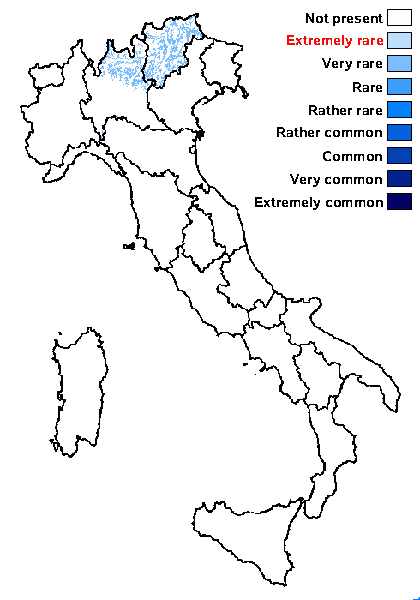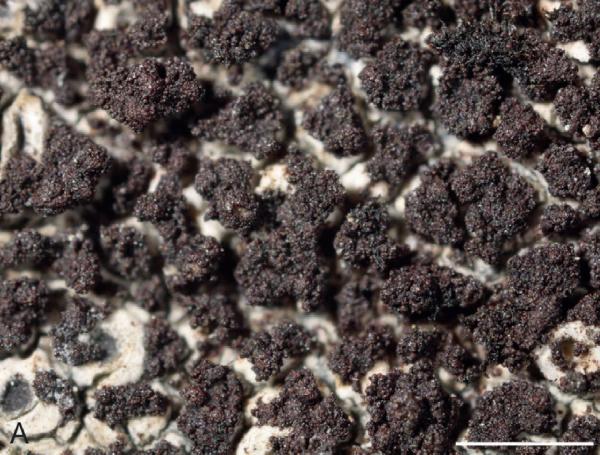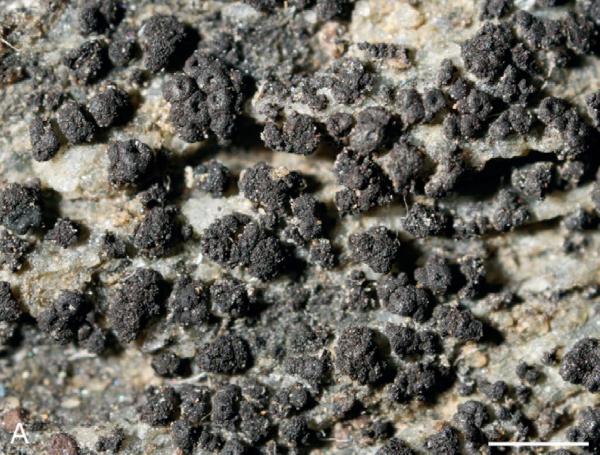Allopyrenis sanguinea (Anzi) M. Schultz & M. Prieto
in Prieto & al., Studies in Mycology, 109: 634, 2024.. Basionym: Pyrenopsis sanguinea Anzi - Atti Soc. Ital. Sc. Nat., 9: 241, 1866.
Synonyms: Psorotichia sanguinea (Anzi) Jatta; Pyrenopsis sanguinea Anzi
Distribution: N - TAA (UPS-L-166875, Nascimbene & al. 2022), Lomb (Schultz 2014).
Description: Thallus crustose, slightly gelatinous when wet, homoiomerous and paraplectenchymatous throughout, reddish to reddish black when dry, red-brown when wet, granulose or granulose-areolate, the areoles more or less rounded in outline, to 1 mm wide, more or less convex, the upper surface distinctly granulose. Apothecia lecanorine, at first semi-immersed, then sessile, appearing perithecioid, 0.25-0.4 mm across, with an initially pore-like, but soon open and flat, dark red-brown disc, and a distinct, persistent, granulose thalline margin, the ascogones formed beneath pycnidia (pycnoascocarps). Proper exciple colourless, very thin and usually poorly evident; epithecium faintly yellowish brown; hymenium colourless, 70-75 µm high, I+ blue; paraphyses simple or sparingly branched in upper part; subhymenium colourless. Asci 8-spored, cylindrical-clavate, unitunicate-rostrate, with a distinct K/I+ blue apical dome and a distinct outer gelatinous cap. Ascospores 1-celled, hyaline, broadly ellipsoid, (5-)6-8(-11) x 5-6 µm. Pycnidia semi-immersed in thalline warts, pyriform, with simple conidiophores. Conidia ellipsoid, c. 3 x 1-1.5 µm, produced terminally. Photobiont cyanobacterial, chroococcoid, the cells single, surrounded by reddish-violet, layered gelatinous sheaths, 10-20 µm wide (incl. sheaths). Spot tests: all negative. Chemistry: without lichen substances. Note: on sunny surfaces of basic siliceous rocks along seepage tracks. This taxon was synonymised by Hafellner & Türk (2001) with Cryptothele rhodosticta, a species whose occurrence in the Alps is dubious (see Jørgensen 2007). According to Schultz (2014), on the contrary, it is a well-distinct species.
Growth form: Crustose
Substrata: rocks
Photobiont: cyanobacteria, coccaceous (e.g. Gloeocapsa)
Reproductive strategy: mainly sexual
On otherwise dry surfaces with short periods of water seepage after rain
Poorly known taxon in need of further study
Commonnes-rarity: (info)
Alpine belt: absent
Subalpine belt: absent
Oromediterranean belt: absent
Montane belt: very rare
Submediterranean belt: absent
Padanian area: absent
Humid submediterranean belt: absent
Humid mediterranean belt: absent
Dry mediterranean belt: absent

Predictive model

Source: Prieto M., Wedin M., Schultz M. 2024. Phylogeny, evolution and a re-classification of the Lichinomycetes. Studies in Mycology, 109: 595-655. - CC BY-NC-ND
A. Allopyrenis sanguinea, crustose, areoles irregular, granulose, pycnoascocarps small with
thick thalline margin narrow, concave disc (Schultz 16954a). Scale bar: 1 mm

S.E. Favero Longo; Owner: Herbarium TO, Department of Life Sciences and Systems Biology, University of Torino CC BY-SA 4.0
Herbarium TO, Cryptogamia-Lichenes, ‘Collezione storica’: TO0030209

S.E. Favero Longo; Owner: Herbarium TO, Department of Life Sciences and Systems Biology, University of Torino CC BY-SA 4.0
Herbarium TO, Cryptogamia-Lichenes, ‘Collezione storica’: TO0031697

Source: Prieto M., Wedin M., Schultz M. 2024. Phylogeny, evolution and a re-classification of the Lichinomycetes. Studies in Mycology, 109: 595-655. - CC BY-NC-ND
Allopyrenis sanguinea, areoles thick, slightly granulose, apothecia semi immersed to sessile and almost globose, discs narrow, later somewhat
opened, thalline margin thick (Anzi Lich. Rar. Langob. 474, W2009-00156, type). Scale bar: 0.5 mm
Growth form: Crustose
Substrata: rocks
Photobiont: cyanobacteria, coccaceous (e.g. Gloeocapsa)
Reproductive strategy: mainly sexual
On otherwise dry surfaces with short periods of water seepage after rain
Poorly known taxon in need of further study
Commonnes-rarity: (info)
Alpine belt: absent
Subalpine belt: absent
Oromediterranean belt: absent
Montane belt: very rare
Submediterranean belt: absent
Padanian area: absent
Humid submediterranean belt: absent
Humid mediterranean belt: absent
Dry mediterranean belt: absent

Predictive model

Source: Prieto M., Wedin M., Schultz M. 2024. Phylogeny, evolution and a re-classification of the Lichinomycetes. Studies in Mycology, 109: 595-655. - CC BY-NC-ND
A. Allopyrenis sanguinea, crustose, areoles irregular, granulose, pycnoascocarps small with thick thalline margin narrow, concave disc (Schultz 16954a). Scale bar: 1 mm

S.E. Favero Longo; Owner: Herbarium TO, Department of Life Sciences and Systems Biology, University of Torino CC BY-SA 4.0
Herbarium TO, Cryptogamia-Lichenes, ‘Collezione storica’: TO0030209

S.E. Favero Longo; Owner: Herbarium TO, Department of Life Sciences and Systems Biology, University of Torino CC BY-SA 4.0
Herbarium TO, Cryptogamia-Lichenes, ‘Collezione storica’: TO0031697

 DOLICHENS
DOLICHENS

